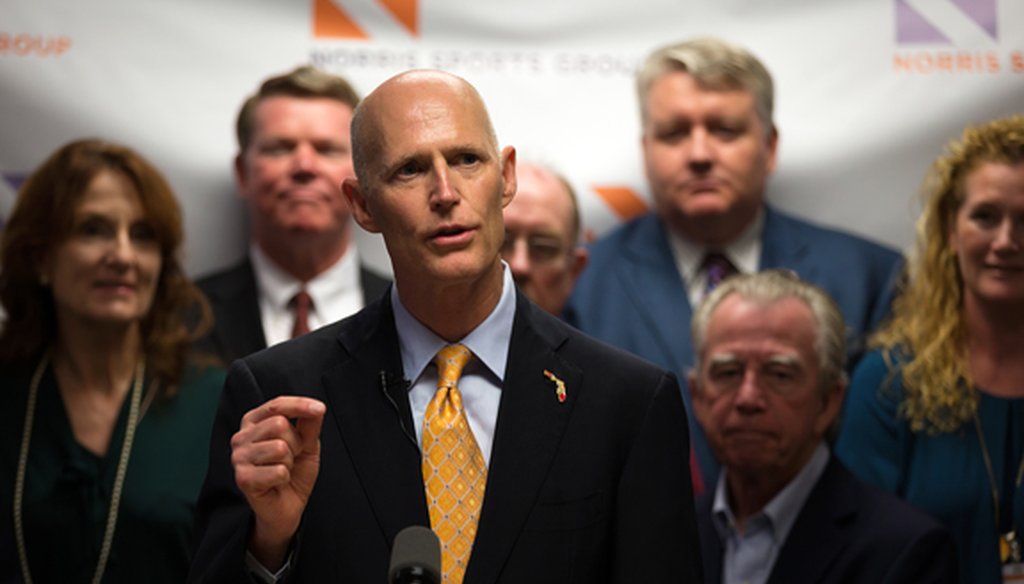Stand up for the facts!
Our only agenda is to publish the truth so you can be an informed participant in democracy.
We need your help.
I would like to contribute

Gov. Rick Scott speaks at a news conference in Naples on March 27, 2015. (AP photo)
Before the Florida Legislature fought to a budget standstill over a hole in health care funding, Gov. Rick Scott said lawmakers should stop worrying about giving state money to profitable hospitals.
His warning came as legislators faced losing the Low Income Pool, or LIP, a joint state-federal program that helps some hospitals and clinics pay for treating uninsured and underinsured patients. Washington last year announced the fund was going to expire in 2015, taking at least $1.3 billion in matching federal funds out of the state budget.
In meetings with senators on April 22, Scott pointed to a list of facilities from the Florida Agency for Health Care Administration. We requested a copy of the list and found it detailed 252 different medical centers, their revenue and their operating margins.
PolitiFact Florida doesn’t know specifically what Scott said to senators or which hospitals he singled out as examples of fueling profits with tax money, so we’re not going to the Truth-O-Meter for this one. We wanted to take a close look at the numbers, though, and see if his general point was on track.
If Scott’s implication was that every hospital that gets LIP money turns a big profit, that’s not accurate.
Under current rules, both nonprofit and for-profit hospitals qualify for LIP money. The fund is paid in part by state, county and local taxes that are matched by the federal government. The pool then reimburses hospitals, doctors, clinics and other providers for treating patients with little or no insurance coverage.
Preference is given to hospitals that provide significant care to low-income patients and are in counties or districts that pay into the fund, but the money also is shared with institutions that don’t pay into the program.
Of 239 hospitals that treat Medicaid patients, 126 of them are anticipated to get a LIP distribution, according to the Florida Agency for Health Care Administration.
We compared the amount of LIP money earmarked for those hospitals to the operating margins on Scott’s list. You can look at Scott’s list here, and the House financial report we used here.
Operating margins are a fair indicator of a hospital’s financial health, showing how much revenue a facility brings in from patients after subtracting the cost to treat them. Linda Quick, president of the South Florida Hospital and Healthcare Association, said there are some caveats, but those margins can provide a quick overview.
"Different institutions account for their money in different ways, but it’s a good way to make an apples-to-apples comparison," she said.
Roughly, we can say about half of the facilities that get LIP money were in the black, according to Scott’s list.
For example, Scott’s handout said Tampa’s nonprofit Moffitt Cancer Center had an $85.7 million operating margin for fiscal year 2013-14. They were projected to get $23.3 million in LIP money this year. Tampa General was earmarked for $62.4 million in LIP funds, with an operating margin of almost $37 million. Halifax Health Medical Center in Volusia County had a $12.2 million operating margin and stood to get $34 million in LIP cash.
Using the list, Orange County’s Florida Hospital ran the highest operating margin of more than $252 million. That hospital received $14.9 million in LIP money.
Now keep in mind, even though these hospitals are in the black, they are being paid for providing services to people with little or no health coverage. And some hospitals treat more indigent patients than others.
Other hospitals get a lot of LIP money but have big operating losses. In Miami-Dade County, the taxpayer-owned Jackson Memorial was slated to get $505 million in LIP funds, but operated at a $291 million loss, according to Scott’s list. The Broward Health system gets some $137 million in LIP distribution, but also lost tens of millions of dollars.
Scott knows a little about how hospitals use money from government healthcare programs. He was CEO of the Columbia/HCA hospital chain about a decade ago, when the company was fined $1.7 billion for Medicare fraud. Scott resigned and was not charged with a crime.
Now that the legislative session is over, Scott has dialed back his heavy-handed posture. On May 5, he issued an executive order creating a Commission on Healthcare and Hospital Funding to study how taxpayer money pays for health care. Their findings are supposed to help inform the Legislature when it reconvenes for budget talks, which must solve the deadlock over expanding Medicaid.
Expansion would alleviate the need for LIP funding, experts said, since it would provide coverage for patients instead of only paying providers for services after the fact.
The House and Senate have not yet agreed upon a date for a special session.
Our Sources
Tampa Bay Times, "Gov. Rick Scott threatens Republican senators with veto power," April 22, 2015
Florida Agency for Health Care Administration, "Update on Diagnosis Related Groups (DRG) Implementation," September 24, 2013
PolitiFact Florida, "Rick Scott 'oversaw the largest Medicare fraud in the nation’s history,' Florida Democratic Party says," March 3, 2014
Florida House of Representatives, "Medicaid Hospital Funding Programs: Fiscal Year 2014-2015," April 29, 2014
Florida Agency for Health Care Administration, "Provider DRG Rate Worksheet FY 2014-2015," July 1, 2014
Florida Center for Investigative Reporting, "Report: Florida’s Hospitals In Jeopardy Of Losing Billions," Nov. 12, 2014
Health News Florida, "Report's Forecast Grim for Hospitals," Jan. 14, 2015
Miami Herald, "Report: Florida hospitals at risk of losing $1.3 billion," Jan. 16, 2015
Highlands Today, "Reports not good for Florida’s ‘safety-net’ hospitals," Feb. 8, 2015
Florida Agency for Health Care Administration, "Study of Hospital Funding and Payment Methodologies for Florida Medicaid," Feb. 27, 2015
About Health, "DRG 101: What Is a DRG & How Does It Work?," March 1, 2015
Florida Senate, "Medicaid Hospital Funding Programs: Fiscal Year 2015-2016," March 20, 2015
PolitiFact Florida, "Rick Scott says feds are 'walking away' from funding Florida's Low Income Pool program," April 14, 2015
Miami Herald, "Miami-Dade mayor: State should fill loss of healthcare fund," April 21, 2015
Center on Budget and Policy Priorities, "Understanding the Issues Surrounding Florida’s Low-Income Pool," April 27, 2015
Tampa Bay Buzz blog, "CMS tells Florida: LIP money not dependent on 'whether or not' state expands Medicaid," April 28, 2015
Tampa Bay Buzz blog, "Gov. Scott says he'll work 'immediately' with Legislature on budget," April 30, 2015
Tampa Bay Times, "Gov. Rick Scott officially convenes commission on hospital spending," May 5, 2015
Gov. Rick Scott's office, Florida hospital profits, accessed April 28, 2015
Community Justice Project, Medicaid expansion reports, accessed May 4, 2015
Gov. Rick Scott's office, Executive Order 15-99, accessed May 5, 2015
Interview with Jeri Bustamante, Gov. Scott spokeswoman, April 28, May 5, 2015
Interview with Shelisha Coleman, Florida Agency for Health Care Administration spokeswoman, April 28-30, May 4-5, 2015
Interview with Greg Mellowe, Florida Center for Fiscal and Economic Policy director of health research and analysis
Interview with Miriam Harmatz, Florida Legal Services senior health attorney, May 5, 2015
Interview with Linda Quick, South Florida Hospital and Healthcare Association president, May 5, 2015


























